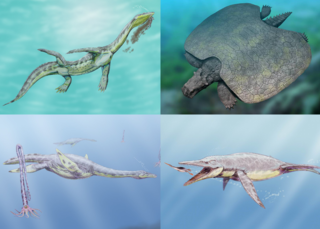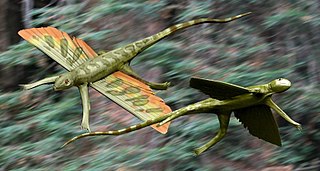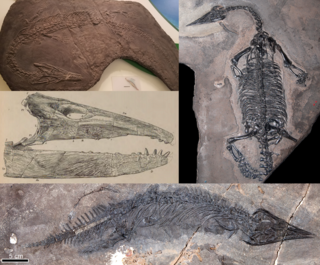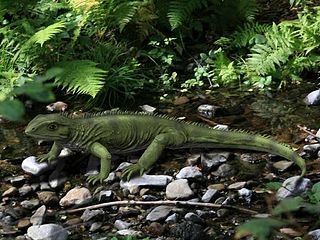
An anapsid is an amniote whose skull lacks one or more skull openings near the temples. Traditionally, the Anapsida are the most primitive subclass of amniotes, the ancestral stock from which Synapsida and Diapsida evolved, making anapsids paraphyletic. It is however doubtful that all anapsids lack temporal fenestra as a primitive trait, and that all the groups traditionally seen as anapsids truly lacked fenestra.

The Lepidosauria is a subclass or superorder of reptiles, containing the orders Squamata and Rhynchocephalia. Squamata includes snakes, lizards, and amphisbaenians. Squamata contains over 9,000 species, making it by far the most species-rich and diverse order of non-avian reptiles in the present day. Rhynchocephalia was a formerly widespread and diverse group of reptiles in the Mesozoic Era. However, it is represented by only one living species: the tuatara, a superficially lizard-like reptile native to New Zealand.

Squamata is the largest order of reptiles, comprising lizards, snakes, and amphisbaenians, which are collectively known as squamates or scaled reptiles. With over 11,500 species, it is also the second-largest order of extant (living) vertebrates, after the perciform fish. Members of the order are distinguished by their skins, which bear horny scales or shields, and must periodically engage in molting. They also possess movable quadrate bones, making possible movement of the upper jaw relative to the neurocranium. This is particularly visible in snakes, which are able to open their mouths very wide to accommodate comparatively large prey. Squamates are the most variably sized living reptiles, ranging from the 16 mm (0.63 in) dwarf gecko to the 6.5 m (21 ft) reticulated python. The now-extinct mosasaurs reached lengths over 14 m (46 ft).

Rhynchocephalia is an order of lizard-like reptiles that includes only one living species, the tuatara of New Zealand. Despite its current lack of diversity, during the Mesozoic rhynchocephalians were a speciose group with high morphological and ecological diversity. The oldest record of the group is dated to the Middle Triassic around 238 to 240 million years ago, and they had achieved a worldwide distribution by the Early Jurassic. Most rhynchocephalians belong to the group Sphenodontia ('wedge-teeth'). Their closest living relatives are lizards and snakes in the order Squamata, with the two orders being grouped together in the superorder Lepidosauria.

Sauropterygia is an extinct taxon of diverse, aquatic reptiles that developed from terrestrial ancestors soon after the end-Permian extinction and flourished during the Triassic before all except for the Plesiosauria became extinct at the end of that period. The plesiosaurs would continue to diversify until the end of the Mesozoic. Sauropterygians are united by a radical adaptation of their pectoral girdle, adapted to support powerful flipper strokes. Some later sauropterygians, such as the pliosaurs, developed a similar mechanism in their pelvis.

Archosauromorpha is a clade of diapsid reptiles containing all reptiles more closely related to archosaurs rather than lepidosaurs. Archosauromorphs first appeared during the late Middle Permian or Late Permian, though they became much more common and diverse during the Triassic period.

Neodiapsida is a clade, or major branch, of the reptilian family tree, typically defined as including all diapsids apart from some early primitive types known as the araeoscelidians. Modern reptiles and birds belong to the neodiapsid subclade Sauria.

Lepidosauromorpha is a group of reptiles comprising all diapsids closer to lizards than to archosaurs. The only living sub-group is the Lepidosauria, which contains two subdivisions, Squamata, which contains lizards and snakes, and Rhynchocephalia, the only extant species of which is the tuatara.

Youngina is an extinct genus of diapsid reptile from the Late Permian Beaufort Group of the Karoo Red Beds of South Africa. This, and a few related forms, make up the family Younginidae, within the Order Eosuchia. Eosuchia, having become a wastebasket taxon for many probably distantly-related primitive diapsid reptiles ranging from the Late Carboniferous to the Eocene, Romer proposed that it be replaced by Younginiformes.

Kuehneosaurus is an extinct genus of Late Triassic kuehneosaurid reptile known from the Late Triassic of the Penarth Group of southwest England and the Steinmergel Group of Luxembourg. Temperature at this stage and region would have ranged from 28 to 35 °C. It was named by P. L. Robinson in 1962 in honour of paleontologist Walther Kühn, and the type and only species is Kuehneosaurus latus. Measuring 72 centimetres long, it had "wings" formed from ribs which jutted out from its body by as much as 14.3 cm, connected by a membrane which allowed it to slow its descent when jumping from trees. It is a member of a family of extinct gliding reptiles, the Kuehneosauridae, within a larger living group the Lepidosauromorpha, which contain modern lizards and tuatara.

Protorosaurus is an extinct genus of reptile. Members of the genus lived during the late Permian period in what is now Germany and Great Britain. Once believed to have been an ancestor to lizards, Protorosaurus is now known to be one of the oldest and most primitive members of Archosauromorpha, the group that would eventually lead to archosaurs such as crocodilians and dinosaurs.

Thalattosauria is an extinct order of prehistoric marine reptiles that lived in the middle to late Triassic period. Thalattosaurs were diverse in size and shape, and are divided into two superfamilies: Askeptosauroidea and Thalattosauroidea. Askeptosauroids were endemic to the Tethys Ocean, their fossils have been found in Europe and China, and they were likely semiaquatic fish eaters with straight snouts and decent terrestrial abilities. Thalattosauroids were more specialized for aquatic life and most had unusual downturned snouts and crushing dentition. Thalattosauroids lived along the coasts of both Panthalassa and the Tethys Ocean, and were most diverse in China and western North America. The largest species of thalattosaurs grew to over 4 meters (13 feet) in length, including a long, flattened tail utilized in underwater propulsion. Although thalattosaurs bore a superficial resemblance to lizards, their exact relationships are unresolved. They are widely accepted as diapsids, but experts have variously placed them on the reptile family tree among Lepidosauromorpha, Archosauromorpha, ichthyosaurs, and/or other marine reptiles.

Kuehneosauridae is an extinct family of small, lizard-like gliding diapsids known from the Triassic period of Europe and North America.

Gephyrosaurus is a genus of early rhynchocephalian first described and named in 1980 by Susan E. Evans. They are distantly related to the extant Sphenodon with which they shared a number of skeletal features including a large tooth row along the side of the palatine bone and posterior process of the dentary bone. The type species, G. bridensis, lived during Early Jurassic in Wales, UK. Whiteside & Duffin (2017) described the second species, G. evansae, known from a partial maxilla recovered from Late Triassic (Rhaetian) fissure fills in Carboniferous Limestone in Somerset. They and other potential gephyrosaurids are the only rhynchocephalians to lie outside Sphenodontia in modern definitions of the group, and have been found to be more closely related to squamates in some phylogenetic analyses.

Reptiles arose about 320 million years ago during the Carboniferous period. Reptiles, in the traditional sense of the term, are defined as animals that have scales or scutes, lay land-based hard-shelled eggs, and possess ectothermic metabolisms. So defined, the group is paraphyletic, excluding endothermic animals like birds that are descended from early traditionally-defined reptiles. A definition in accordance with phylogenetic nomenclature, which rejects paraphyletic groups, includes birds while excluding mammals and their synapsid ancestors. So defined, Reptilia is identical to Sauropsida.

Protorosauria is an extinct, likely paraphyletic group of basal archosauromorph reptiles from the latest Middle Permian to the end of the Late Triassic of Asia, Europe and North America. It was named by the English anatomist and paleontologist Thomas Henry Huxley in 1871 as an order, originally to solely contain Protorosaurus. Other names which were once considered equivalent to Protorosauria include Prolacertiformes and Prolacertilia.

Marmoretta is an extinct genus of small lepidosauromorph reptile known from the Middle Jurassic of Oxfordshire, England and Skye, Scotland. It contains a single species, Marmoretta oxoniensis.
This list of fossil reptiles described in 2021 is a list of new taxa of fossil reptiles that were described during the year 2021, as well as other significant discoveries and events related to reptile paleontology that occurred in 2021.
Palaeagama is an extinct genus of neodiapsid reptile from the Late Permian or Early Triassic of South Africa. It is based on an articulated skeleton which was probably found in the Early Triassic Lystrosaurus Assemblage Zone, or potentially the Late Permian Daptocephalus Assemblage Zone. Despite the completeness of the specimen, Palaeagama is considered as a "wildcard" taxon of uncertain affinities due to poor preservation. It was originally considered an "eosuchian", and later reinterpreted as a lizard ancestor closely related to Paliguana and Saurosternon. Modern studies generally consider it an indeterminate neodiapsid, though a few phylogenetic analyses tentatively support a position at the base of Lepidosauromorpha.
Saurosternon is an extinct genus of neodiapsid reptile from the Late Permian of South Africa. It is based on a partial skeleton split between two slabs of sandstone from the Daptocephalus Assemblage Zone. Saurosternon was one of the earliest small lizard-like reptiles to be discovered in Permian deposits of the Karoo Supergroup, preceding later discoveries such as Paliguana, Youngina, Palaeagama, and Lacertulus. The skeleton is mostly complete, though missing the head. Most of the original bone had decayed away by the time the fossil was discovered, leaving perfect molds in the sandstone slabs. What little bone remained was removed with acid by museum preparators, and the specimen was cast with latex to reconstruct the original bone shape.















